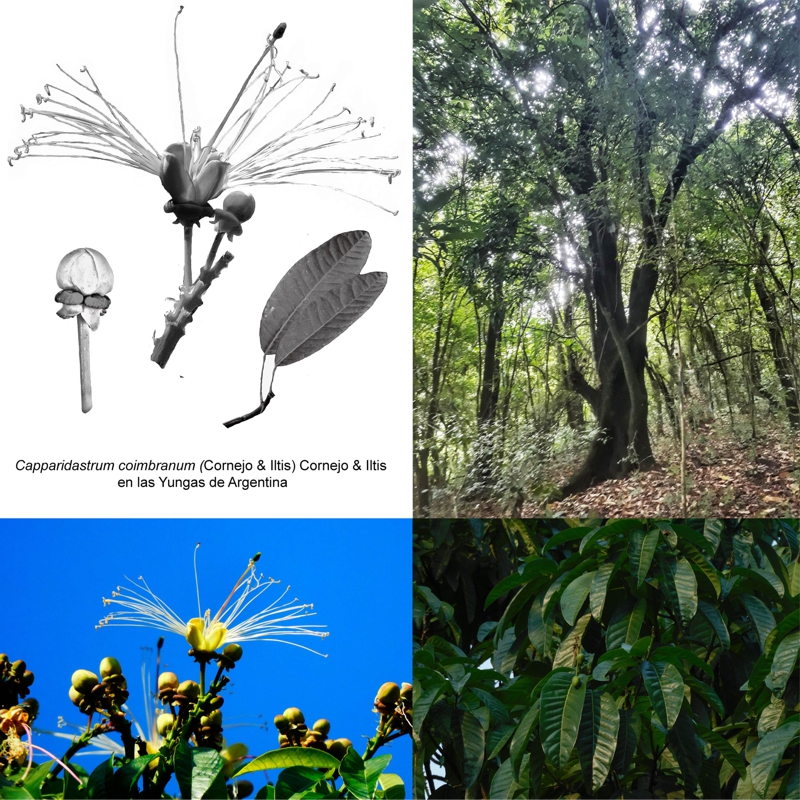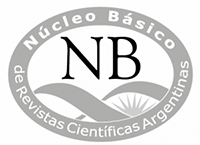Capparidastrum coimbranum (Capparaceae) in the Yungas of Argentina (sierras de Alto Macueta and del Alto Río Seco, Salta Province)
DOI:
https://doi.org/10.31055/1851.2372.v60.n2.47590Keywords:
Bioclimatology, Capparaceae, distribution, ecology, morphology, montane rainforest, premontane forestAbstract
Background and aims: This work is a contribution to the knowledge of Capparidastrum coimbranum in Argentina, a little known tree species recorded only in the Yungas of the north of Salta Province (Sierras de Alto Macueta and del Alto Río Seco). The present study aims to provide a description of the material corresponding to C. coimbranum collected in the Sierras de Alto Macueta, as well as to characterize floristically, ecologically and bioclimatically the forest of C. coimbranum found in this mountain range.
M&M: A morphological description of the material collected in the Sierras de Alto Macueta was prepared. For the characterisation of the C. coimbranum forest, a floristic inventory was carried out and its abundance and cover were determined. The altitudinal, latitudinal and bioclimatic distribution of C. coimbranum in the study area was established.
Results: The morphological description of the species, information on its distribution and habitat, phenology, uses and photographs are provided. Capparidastrum coimbranum dominates a woody community in the Thermotropical and Mesotropical Subhumid Premontane Forest of the Sierras de Alto Macueta. Isolated individuals were also found in the Subhumid Mesotropical Montane Rainforest of the Sierras del Alto Río Seco.
Conclusions: The presence of C. coimbranum in the Sierras de Alto Macueta and del Alto Río Seco extends its latitudinal distribution southwards out of Bolivian territory. For the first time, a forest dominated by a neotropical Capparaceae is described for the Argentine Yungas. This work is a contribution to the knowledge of the flora and vegetation of the Yungas of Argentina.
References
CABRERA, A. L. 1994. Regiones fitogeográficas de la República Argentina. Enciclopedia de Agricultura, Jardinería y Fruticultura. Ed. Acme, Buenos Aires.
CARRETERO, A. L. 2005. Useful Plants and Traditional knowledge in the Tucumano-Boliviano Forest. M. Sc. Thesis. Institute of Biological Science, University of Aarhus, Denmark.
CAYOLA, L., A. FUENTES & P. M. JØRGENSEN. 2005. Estructura y composición florística de un bosque seco subandino yungueño en el valle del Tuichi, Área Natural de Manejo Integrado Madidi, La Paz (Bolivia). Ecol. Boliv. 40: 396-417.
CHIRI, W. F. 2015. Plantas comestibles nativas y naturalizadas del Parque Nacional y Área Natural de Manejo Integrado Serranía del Iñao Chuquisaca Bolivia. Agro-Ecológica 2:170-179.
CHOQUE-AJATA, D. 2007. Composición florística y uso tradicional de especies en el bosque seco del PN y AMNI Madidi, Apolo, provincia Franz Tamayo. Tesis de Grado. Universidad Mayor de San Andrés, Bolivia.
CORNEJO, X. 2018. Notes on the nomenclature of neotropical Capparaceae: an answer to global flora. Harvard Papers in Botany 23:179-185. https://doi.org/10.3100/hpib.v23iss2.2018.n3
CORNEJO, X. & H. H. ILTIS. 2005. Studies in the Capparaceae XXIII: Capparis coimbrana, a new species from Bolivia. Brittonia 57:155-161.
CORNEJO, X. & H. H. ILTIS. 2008. The reinstatement of Capparidastrum (Capparaceae). Harvard Pap. Bot. 13: 229-236.
CORNEJO, X. & H. H. ILTIS. 2012. Capparaceae. En: CARVAJAL S. &L. M. GONZALLES-VILLAREAL (eds.), La flora de Jalisto y áreas colindantes, fasc. 25, pp. 1-67. Universidad de Guadalajara. Guadalajara.
FERNÁNDEZ-CHOQUE, A. T. 2008. Estructura de composición florística del bosque seco deciduo subandino en el Parque Nacional y Área Natural de Manejo Integrado Madidi, La Paz, Bolivia. Tesis de Grado. Universidad Mayor de San Andrés, Bolivia.
GALLEGOS, S. C., F. S. ZENTENO-RUIZ, S. G. BECK & R. P. LÓPEZ. 2019. Diversidad arbórea del bosque tucumano-boliviano en la alta cuenca del río Bermejo (Tarija, Bolivia). Ecol. Boliv. 54: 18-39.
GRAU, A., L. R. MALIZIA & A. D. BROWN. 2016. Arboretum Calilegua. Árboles nativos y exóticos del noroeste argentino. Ed. Del Subtrópico, Yerba Buena.
ILTIS, H. H. 2005. Studies in the Capparaceae XXIV: Edward Palmer in Corumbá, Brazil, and the first collection of Capparis coimbrana. Brittonia 57:162-166.
LIMA, M. S. D. & G. A. DAMASCENO-JUNIOR. 2020. Phenology and dispersal syndromes of woody species in deciduous forest fragments of the Pantanal in Mato Grosso do Sul State, Brazil. Acta Bot. Bras. 34:312-326. https://doi.org/10.1590/0102-33062019abb0353
LINARES-PALOMINO, R., V. CARDONA, D. SOTO, S. K. HERZOG & M. KESSLER. 2008. Tree community patterns along a deciduous to evergreen forest gradient in central Bolivia. Ecol. Boliv. 43:79-98.
LINO-VILLALBA, O.A., M. TOLEDO, M.T. MARTÍNEZ-UGARTECHE, L. ARROYO-HERBAS, ... & D. VILLARROEL. 2022. Plantas nativas con valor socioeconómico de la nación Monkoxi de Lomerío, Santa Cruz, Bolivia. Ecol. Boliv. 57: 57-82.
LOZA, I., M. MORAES & P. M. JØRGENSEN. 2010. Variation of diversity and floristic composition in relation to elevation in a Bolivian montane forest (PNANMI Madidi). Ecol. Boliv. 45: 87-100.
MERCADO-GÓMEZ, J. D. & T. ESCALANTE. 2018. Areas of endemism of the Neotropical species of Capparaceae. Biol. J. Linn. Soc. 126:507-520. https://doi.org/10.1093/biolinnean/bly186
MOSQUEIRA-MENESES, E. 2015. Evaluación de la dinámica de un bosque semideciduo de la región Madidi. Tesis Doctoral. Universidad Mayor de San Andrés, Bolivia.
PALOMEQUE DE LA CRUZ, S. 2012. Biodiversidad y estado de conservación Reserva Nacional de Flora y Fauna Tariquía y zonas de amortiguamiento. Editorial GTZ, MAPZA, La Paz.
PANFIGLIO, T., X. CORNEJO & M. A. FARINACCIO. 2018. Check-list de Capparaceae do estado de Mato Grosso do Sul, Brasil. Iheringia, Sér. Bot. 73 (supl.): 174-177. http://dx.doi.org/10.21826/2446-8231201873s174
PAREDES-SALINAS, S. R. 2008. Composición, Estructura y Biomasa del Bosque Semidecduo Andino del Valle Del Rio San Juan, Parque Nacional Madidi. Tesis de Grado. Universidad Mayor de San Andrés, Bolivia.
PAZ-ROCA, M. A. & B. MOSTACEDO. 2020. Biomasa aérea de árboles en bosques secos de la Ecorregión Chiquitana en Alta Vista, Santa Cruz, Bolivia. Kempffiana 16: 1-15.
RIVAS-MARTÍNEZ, S. 2008. Global Bioclimatics (“Clasificación Bioclimática de la Tierra”). Disponible en: http://www.globalbioclimatics.org.
RIVAS-MARTÍNEZ, S., G. NAVARRO, A. PENAS & M. COSTA. 2011a. Biogeographic map of
South America. A preliminary survey. Int. J. Geobot. Res. 1: 21-40.
RIVAS-MARTÍNEZ, S., S. RIVAS-SÁENZ & A. PENAS-MERINO. 2011b. Worldwide bioclimatic classification system. Glob. Geobot. 1: 1-638.
SERRANO-PACHECO, M. 2003. Estructura y composición de bosques montanos subtropicales y sus implicaciones para la conservación y el manejo de los bosques forestales en la serranía del Iñao, Bolivia. Tesis de maestría. Universidad Nacional de Costa Rica, Turrialba.
SOARES-NETO, R.L. & J. Luber. 2020. Capparaceae in Flora e Funga do Brasil. Jardim Botânico do Rio de Janeiro. Disponible en: https://floradobrasil.jbrj.gov.br/FB129498 [Acceso: 28 abril 2025].
THIERS, B. 2025. (actualizado continuamente). Index Herbariorum. Disponible en: http://sweetgum.nybg.org/science/ih. [Acceso: 26 marzo 2025].
TORREZ-FLORES, V. W. 2008. Estructura y patrones de diversidad vegetal leñosa en relación a topografía y variables edáficas-Sector de bosque seco semideciduo subandino (Río San Juan, Parque Nacional Madidi, Bolivia). Tesis Doctoral. Universidad Mayor de San Andrés, Bolivia.
VÁSQUEZ, R. & G. COIMBRA. 2002. Frutas Silvestres Comestibles de Santa Cruz. Fondo Editorial, Gobierno Municipal, Santa Cruz de la Sierra.
VARGAS, C., G. ISRAEL & C. G. JORDÁN. 2003. Principales Plantas Útiles del Bajo Paraguá, Santa Cruz-Bolivia. Guía de Campo. Editorial FAN, Santa Cruz de la Sierra.
VILLALBA, M. S., G. S. ENTROCASSI & E. MARTÍNEZ-CARRETERO. 2021. Composition, structure and diversity of the arboreal vegetation of the Subtropical Mountain Forests or Yungas at the northern extreme of Argentina (Sierras de Tartagal, Alto Macueta and del Alto Rio Seco, Province of Salta). Int. J. Geobot. Res. 10: 45-74. http://dx.doi.org/10.5616/ijgr211004
VILLALBA, M. S., G. S. ENTROCASSI & E. MARTÍNEZ-CARRETERO. 2024. Bioclimatic characterisation of the Subtropical Mountain Forests or Yungas at the northern extreme of Argentina: Sierras de Tartagal, Alto Macueta and del Alto Rio Seco (Salta Province). Mediterr. Bot. 45: e87801. http://dx.doi.org/10.5209/mbot.87801
VILLARROEL, D., G. M. ARAMAYO, M. T. MARTÍNEZ, C. E. PROENÇA, … & M. H. NEE. 2017. Historia natural del Cerro Mutún: VI. Checklist, estatus de conservación y nuevos registros para Bolivia. Kempffiana 3: 29-74.
ZULOAGA, F. O., M. J. BELGRANO & A. M. ANTON (eds.). 2023. Flora Argentina: Flora Vascular de la República Argentina. Disponible en: http://www.floraargentina.edu.ar/ [Acceso: 1 abril 2025].

Downloads
Published
Issue
Section
License
Copyright (c) 2025 Maria S. Villalba, Gabriela S. Entrocassi, Gloria J. Ramos, Eduardo Martínez- Carretero

This work is licensed under a Creative Commons Attribution-NonCommercial-NoDerivatives 4.0 International License.
Provides immediate and free OPEN ACCESS to its content under the principle of making research freely available to the public, which fosters a greater exchange of global knowledge, allowing authors to maintain their copyright without restrictions.
Material published in Bol. Soc. Argent. Bot. is distributed under a Creative Commons Attribution-NonCommercial-ShareAlike 4.0 International license.










